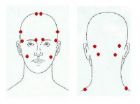(Press-News.org) This release is available in French and Spanish.
Scientists at the University of Granada have confirmed that injecting a local anesthetic or botulinum toxin (botox) into certain points named "trigger points" of the pericraneal and neck muscles reduce migraine frequency among migraine sufferers. University of Granada researchers have identified the location of these trigger points –which activation results in migraine– and their relationship with the duration and severity of this condition.
Headache is a universal experience. At present, there are more than 100 different types of headache and one of the most recurring ones is migraine, which affects approximately 10-12% of the population, being three times more common in women than in men. When migraine becomes chronic –occurring more than 15 days a month–, it can disrupt patients' daily life in a great degree.
This research study is one of the three studies that have been conducted by Juan Miguel García Leiva –a researcher at the University of Granada Institute for Neuroscience "Federico Oloriz" – and coordinated by professor Elena Pita Calandre.
Trigger points in migraine sufferers
In the first study, researchers examined a sample of healthy subjects and patients with a diagnosis of migraine –any frequency–, and analysed the presence of trigger points and their location, many of the explorations resulting in a migraine crisis. The most interesting findings of this study were: 95% of migraine sufferers have trigger points, while only 25% of healty subjects have them. The most common locations of trigger points are the anterior temporal and the suboccipital region, both billateral, of the head. Furthermore, researchers found a positive correlation among the number of trigger points in a patient, the number of monthly crises and the duration in years of the condition.
Subsequently, researchers conducted another study with 52 migraine sufferers (with migraine refractory to common pharmacological treatments). During three months, patients received a weekly subcutaneous injection of 1mL of a local anesthetic into their trigger points.
After the injection of the anesthetic, 18% of patients experienced a 50% or higher reduction in the frequency of migraine crises, as compared with the basal period. Additionally, an 11-49% reduction of frequency was observed in 38% of patients. Two thirds of the patients treated reported to feel "better or much better".
Few side effects
In the third study, 25 patients with chronic migraine were injected with 12.5 doses of botox into each trigger point twice, during a period of 3 months. Frequency (main variable), intensity and scales of migraine crises were recorded one month before and one month after the treatment to compare the changes experienced. In addition, side effects were also recorded during the experiment, and they were found to be mild and temporary.
After the injections, the most significant decrease in crisis frequency was observed at week 20. Similar results were obtained in those crises labelled as "moderate" and in the frequency of analgesic use by patients.
García Leiva specified that this treatment "is not a first-choice treatment for migraine sufferers, but it can only be applied in patients with chronic migraine who have tried several treatments with poor results, and who show peripheral sensitization of muscles. Recently, the Foods and Drugs Administration (USA) has approved botulinum toxin as a therapeutical drug for the treatment of chronic migraine.
INFORMATION:
References:
1. Trigger point evaluation in migraine patients: an indication of peripheral sensitization linked to migraine predisposition? Calandre EP, Hidalgo J, García-Leiva JM, Rico-Villademoros, F. European Journal of Neurology 2006, 13: 244�
2. Effectiveness of Ropivacaine Trigger Points Inactivation in the Prophylactic Management of Patients with Severe Migraine. García-Leiva JM, HidalgoJ,Rico-Villademoros F, Moreno V, Pain Medicine 2007, 8 (1): 244-249
3.- Hidalgo J, Rodríguez-López CM, García-Leiva JM, Rico-Villademoros F, Calandre EP. Effectiviness botulinum toxin type A in the prophylaxis of severe and treatment–refractory migraine. J Headache Pain, 2006; 7(S-1): p. S-18.
Contact: Juan Miguel García Leiva. Institute for Neurociences "Federico Olóriz". University of Granada. Cell-phone: +34 610 69 17 80. E-mail address: jmgleiva@ugr.es
Accessible on English version
Accesible en Versión española
Accessible sur le site Version française
Botox injected in head 'trigger point' is proven to reduce migraine crises
2011-05-11
ELSE PRESS RELEASES FROM THIS DATE:
'Liquid smoke' from rice shows potential health benefits
2011-05-11
Liquid smoke flavoring made from hickory and other wood — a mainstay flavoring and anti-bacterial agent for the prepared food industry and home kitchens — may get a competitor that seems to be packed with antioxidant, antiallergenic and anti-inflammatory substances, according to a new study in ACS' Journal of Agricultural and Food Chemistry. It is the first analysis of liquid smoke produced from rice hulls, the hard, inedible coverings of rice grains.
Mendel Friedman, Seok Hyun Nam and colleagues explain that wood from trees is typically used to produce liquid smoke, ...
Mayo Clinic reports new findings on noninvasive test for pancreatic cancer
2011-05-11
ROCHESTER, Minn. - Pancreatic cancer has one of the highest mortality rates of any of the major cancers, and of the 43,000-plus Americans diagnosed with the disease each year, more than 94 percent die within five years of diagnosis. One reason for this high number of deaths is a lack of effective screening tools for catching the disease early. Now, in an effort to try to gain the upper hand on this deadly form of cancer, Mayo Clinic researchers believe they have found a new way to test for pancreatic cancer with DNA testing of patients' stool samples. The research was presented ...
OwnDepot Inc. Launches OwnDepot.com, a Destination Website for Homeowners to Manage the Well Being of Their Homes.
2011-05-11
Doug Huggins Founder of OwnDepot announced today that the company website, www.owndepot.com has officially launched. The Site provides the insured community with a secure inventory solution that allows the customer or a designated agent to inventory all home valuables. OwnDepot provides proof of ownership by recording detailed purchase information, while providing customers with tools to help them manage their home life.
OwnDepot has created a new market category - a Home Management Solution that focuses on personal asset management and household simplification. It ...
Serendipity leads to lifesaving discovery
2011-05-11
About two years ago, Dr. Philippe Gros, a McGill University professor in the Department of Biochemistry and a Principal Investigator in thd McGill Life Sciences Complex, described a mouse mutant that was immunodeficient and hypersensitive to the Bacille Calmette-Guérin (BCG) vaccine and to tuberculosis (TB). In this model, Gros's team had found that the immunodeficiency was caused by a mutation in a regulatory protein of the immune system named IRF8.
A year later, a physician in Newcastle who had heard about Gros's work, contacted him about a three-month-old patient ...
Lessening the dangers of radiation
2011-05-11
For diagnosing head and neck ailments, tests that use radiation are always less desirable than those that don't. Otolaryngologists have a wide range of techniques available to them, including CT or "CAT" scans, MRI and ultrasound. CT uses significant radiation and MRI a lower amount, but ultrasound is a non-invasive, non-radiating technique. It does not require injection of radioactive contrast material and has no side effects.
Now, a new study by Tel Aviv University exploring the efficacy of expensive and invasive CT scans has found that, in some cases, they don't offer ...
Yale researchers explain why cancer 'smart drugs' may not be so smart
2011-05-11
Some of the most effective and expensive cancer drugs, dubbed "smart drugs" for their ability to stop tumors by targeting key drivers of cancer cell growth, are not effective in some patients. In two related studies, Yale School of Medicine researchers examined one such driver, the EGF receptor (EGFR), and found that a decoy receptor might be limiting the amount of drug that gets to the intended target.
"We know that smart drugs like Cetuximab are not always effective in the cancer cells they're supposed to target because there are no positive predictive markers for ...
Reforesting rural lands in China pays big dividends, Stanford researchers say
2011-05-11
An innovative program to encourage sustainable farming in rural China has helped restore eroded forestland while producing economic gains for many farmers, according to a new study by Stanford University researchers.
Their findings are published in the Proceedings of the National Academy of Sciences (PNAS).
"The Sloping Land Conversion Program, which began in 2000 after massive flooding caused in part by land clearing, focuses on China's largest source of soil erosion and flood risk – farms on steep slopes," said study co-author Gretchen Daily, a professor of biology ...
Webcast Discussing Judge Scheindlin's Recent NDLON Ruling on ESI Productions and Metadata Now Available Online
2011-05-11
ZyLAB, a leading eDiscovery and information management technology company, today announced that the popular webcast titled "Contemporary Productions and Metadata for 21st Century Disclosures" is now available on demand from the company's website. The lively and informative 80-minute webcast addresses the controversy surrounding the recent ruling in the National Day Laborer Organizing Network (NDLON) v. US Immigration and Customs Enforcement Agency (ICE) case involving ESI productions and metadata.
NDLON plaintiff counsel, Anthony Diana, of Mayer Brown LLP, ...
Practice, not loss of sight, improves sense of touch in the blind: study
2011-05-11
New research from McMaster University may answer a controversial question: do the blind have a better sense of touch because the brain compensates for vision loss or because of heavy reliance on their fingertips?
The study, published in the most recent edition of the Journal of Neuroscience, suggests daily dependence on touch is the answer.
Twenty-eight profoundly blind participants—with varying degrees of Braille expertise—and 55 normally sighted adults were tested for touch sensitivity on six fingers and both sides of the lower lip.
Researchers reasoned that, ...
Vitamins may hitch a protected ride on corn starch
2011-05-11
Vitamins and medications may one day take rides on starch compounds creating stable vitamin-enriched ingredients and cheaper controlled-release drugs, according to Penn State food scientists.
The technique may offer drug and food companies a less expensive, more environmentally friendly alternative in creating, among other products, medications and food supplements.
In a series of experiments, researchers formed pockets with corn starch and a fatty acid ester to carry oil soluble vitamins, such as vitamin A and vitamin C, into the body, according to Gregory Ziegler, ...



